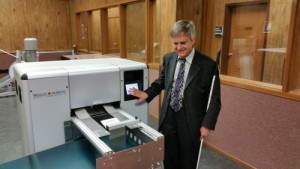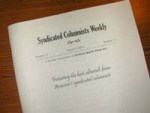By Steve Booth
For several decades, the discussion about changing the braille code to Unified English Braille (UEB) has sparked passionate feelings. This code, named for its inventor Louis Braille, has been around for over 200 years and has served the blindness community well. January 2016 is the date that the Braille Authority of North America (BANA) has determined, after much consideration, to be the adoption date of UEB in the United States and feelings continue to be mixed. Anticipation, trepidation, and many, many questions still surround UEB.
Recently, NBP Publisher, Diane Croft, spoke with Steve Booth, a former NBP employee and current Braille Specialist at the National Federation of the Blind. When he proclaimed to "love UEB" we knew we needed him to post his thoughts on our blog.
Here is Steve's take on UEB:
I admit I had my doubts about changing even one dot of a code that has worked so well since 1824.
Today I’m ready to concede that those who took a leadership role back in 1991 toward what is now the Unified English Braille Code (UEB) were true visionaries.
They started with the premise that any system can be improved. It’s hubris to think otherwise. They then dove into the mechanics of what exactly should be improved and what could be left alone. They did this with several audiences in mind: the braille reader, the producer, the transcriber, and the braille teacher.
They were also looking at a code that, although it worked remarkably well with computer technology, still required human intervention to fix those parts that didn’t work. I know first-hand about those fixes! Formerly I worked as an assistant production manager at National Braille Press and now work in the Braille Certification Program of the Library of Congress, administered by the National Federation of the Blind. UEB has made my life far simpler . . . but I’m jumping ahead of myself.
The primary goal, according to the records of 1991, was to “make the acquisition of reading/writing/teaching braille easier and more efficient . . . [to] help reverse the trend of steadily eroding usage of braille itself.” Given the abysmal rate of 9.5% of blind school-age children who list braille as their primary reading mode, this makes good sense.
All told, UEB eliminates nine contractions that were found to be the most ambiguous: by, into, to, ble, com, dd, ation, ally, and the o’clock contraction. Each of these could represent something other than themselves, depending on their placement in a word.
UEB is also closer to its print equivalent, for example, braille will no longer join the contractions “of, and, for, the, with” in sequence without spaces. And the period. There is now only one dot formation for a period, instead of four different ways to represent it. Just as there are opening and closing parentheses in print, the same is true for braille. Word division is no longer recommended: “It is no longer preferable for words to be hyphenated.” When was the last time you used a dictionary to divide words between lines? I never did until I worked in the field. We have spent way too much time teaching word division to potential transcribers.
The list of improvements goes on, too many to elaborate on in a blog post. As a braille reader since the early 1960s, I have quickly adjusted to UEB. Anyone interested in acquiring some UEB skills while reading good material should subscribe to Syndicated Columnists Weekly,  a short weekly from National Braille Press. I’ve been reading it for decades. NBP started producing it in UEB at the beginning of the year and I was able to adjust to new UEB symbols in the context of the material. NBP also offers a free UEB Briefs Symbols list if you ask for it (orders@nbp.org).
a short weekly from National Braille Press. I’ve been reading it for decades. NBP started producing it in UEB at the beginning of the year and I was able to adjust to new UEB symbols in the context of the material. NBP also offers a free UEB Briefs Symbols list if you ask for it (orders@nbp.org).
As a braille producer, my life is far easier. I no longer need to search for hyphens and dashes (to eliminate spaces around them) because braille now follows print rules. I can more accurately translate documents from braille to print with better results. Without word division, braille production is faster, plus the code offers more flexibility in handling the large variety of print styles now in use.
All in all, I’m completely in favor of these changes for a host of reasons that I would not have understood had I not been a braille producer, trainer, and reader. And did I mention, America has now joined six other English-speaking nations in its adoption of UEB, which means we all share the same code. I think Louis would have been pleased about that. His code was meant to be useful, above all.
